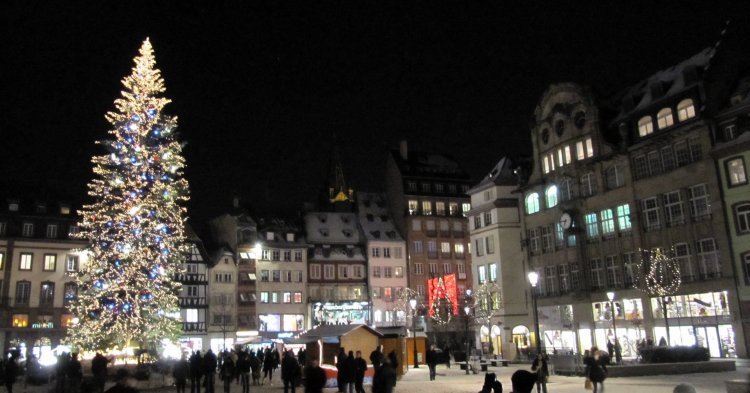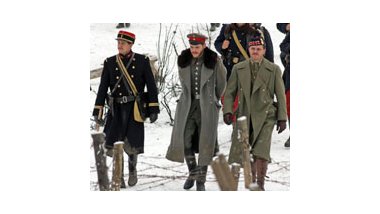Madara from Riga, Latvia celebrates in the Netherlands
In Latvia Christmas is strongly influenced by heathen traditions regarding winter solstice. Naturally, people go to church and afterwards they roll a block of wood around the house to then burn it down, to get rid of all worries of the past year and to chase away evil spirits. With masks on their heads people dance. When it comes to food nine-course meals are mandatory, traditionally peas with ham sauce, little meat-filled cakes, gingerbread or sour cabbage. The time for gifts is late evening on the 24th or the 25th. For every gift one must recite a poem or dance. Therefore, children learn a lot of poems before Christmas! The mix of traditions proves that the winter solstice and Christmas is about the same thing: the return of the light.
In the Netherlands Sinterklaas and ’Zwarte Pieten’ (black peter) come with the ship from Spain. Who was behaving well and left carrots in his shoes for his horse will get gifts. Recently there is an argument if black Pete is not portrayed racialistically. Hence in some regions he was replaced by Minions.
Alexandra from Chabarovsk, Russia:
According to the Russian-orthodox calendar Christmas is on January 7th. Some Russians don’t celebrate Christmas at all. During the Soviet period many traditions got lost. For the others January 6th is the day to put up the Christmas tree. At the divine service at the church people have to stand for four hours till its end late at night, therefore Father Frost has to distribute the gifts the next day. Very important and popular on the other hand is New Year’s Eve. We celebrate it late evening with a lot of food and for many families this already is the day for gifts. There is chicken with mashed potatoes, fruits, lots of alcohol, olives and fish salad with beetroot, potatoes, onions and carrots called ’herring under the fur coat’. There are not as many fireworks like in other countries like Germany.
Aphrodite from Athens:
On the 24th the children walk around to sing Christmas songs and collect money from their neighbours for the holidays. They do the same on New Year’s Eve and on January 5th before Epiphany. On 25th the whole family is meeting for dinner. The day for gifts is the 31st of December. In the night Saint Vasilis hides them under the Christmas tree. Between Saint Nicholas Day on December 6th and Epiphany on January 6th traditional cakes are baked, like ’Melomakarona’ and ‘Kourabiedes’, made of semolina, cinnamon, cloves and honey or shortbreads with rose water and icing sugar. On New Year ’Vasilopita’, a cake decorated with a cross and the year date is served in equal pieces to all guests. One coin is hidden in the cake and the person who finds it will have good luck in the coming year!
Ivana from Slavonia, Croatia:
Every region in Croatia has its own traditions and the food is regionally very diverse, too. On Christmas Eve during the day no meat is served, instead fish or squid is eaten with potato salad and vegetables. In addition, a festive meal is prepared for the Christmas Days. For example, Sarma (with mincemeat stuffed cabbage rolls in tomato sauce), soup and roast meat, pies nut or poppy slices. While mothers prepare the food fathers and children decorate the Christmas tree. At 11:30 PM the church service starts so people can ’celebrate into’ December 25th. Afterwards respectively the next morning the presents are unwrapped. The first Christmas Day one usually visits the parents for having dinner together.
Eva describes from Ptuj, Slovenia:
The political system in Yugoslavia tended to reject Christian holidays, tried to promote the New Year celebrations and invented ’Dedek Mraz’ (Father Frost) to replace Father Christmas. As a result, nowadays some families wait for Father Frost, others for Santa Clause and in rare cases even for both, which is very joyful for the children because they get two times the gifts. In addition, ’Miklavž’ or Saint Nicholas, who of course belongs to Christmas as well, visits the children December 6th to hide sweets, fruits and sweet bread in their shoes. Those who didn’t behave well get the rod. Miklavž is not alone but is joined by little devils, that rattle with chains to scare the children till they say a prayer to get their presents.
Francesco from the Sorrentine Peninsula, Italy:
In Italy Christmas is celebrated very differently in each region of the country. The celebrations in the region of Naples include three challenges for the stomach: the nightly meal on 24th and lunch on 25th and 26th of December. These culinary highlights are accompanied by rituals, games and other traditions. The Christmas Tree that is usually made of plastic is put up regularly on December 8th the day of Marie’s Immaculate Conception. At noon on 24th the preparations for the dinner begin. Since the whole family needs to be satisfied the preparation is quite costly. In Naples ’Baccala´ fritto’ (fried codfish) or eel is a traditional meal. A lot of desserts are served like ’Struffoli’ (pea-sized paste balls covered in a mixture of honey, rum, mandarin zest and rosemary) or traditional biscuits like ’Mustacciuoli’, ’Roccoco’ and ’Susamielli’. Most important supplements are all kinds of nuts. At midnight baby Jesus is laid in the manger and everybody goes to church. Afterwards in the night Santa Clause is bringing the gifts and the celebrations go on till the early morning. In Naples a kind of bingo (’Tombola napoletana’) or cards are played during the whole night. The procedure on December 25th on the other hand is quite simple: one gets up very late and eats meat for lunch. The meal takes till 4 PM then people continue eating nuts and playing traditional games, so that the whole day is spent together. On 26th the Christmas mood slowly disappears while the family hilariously enjoys the rest of the time together. Usually the rests of the previous meals are eaten. For me Neapolitan Christmas is baking, eating, Tombola and happiness.
Monika from Warsaw, Poland:
In Poland it is tradition to prepare a twelve-course meal. One for every apostle. There are dumplings with collard and mushrooms, ’Bigos’ (cabbage with all kinds of meat), red borscht, poppy-seed cake and carp as main dish. One seat is always prepared for an unexpected guest. At midnight people go to church for the divine service where a lot of singing takes place. The two Christmas Days are spent with the family.
Gudri from Lithuania celebrates in Iceland:
The 24th we fast, clean the house and prepare twelve cold courses for the meal. Most of the time people eat beetroot, mushrooms and potted fish. On the other hand, food should be as vegan as possible, so that we avoid dairy products and eggs. ’Kuciukai’ (poppy-seed cake), linseed with garlic and salt, potatoes, dark bread and honey are essential. Under the table we hide straw to predict the next year. The one who draws the longest one, will have the most good luck. There is always one additional plate on the table, in case a deceased soul decides to visit the family. The sanctified bread gets shared which seems to be the only real Christianity during the celebrations. Most traditions descend from heathenish origin.
Everybody has to try out all twelve courses and some scraps are left for wandering souls. At the countryside it is typical that people go to the barn to listen if the animals talk in human language to predict the future. Then people go to church and the next morning is the time for gifts. Christmas is very similar to New Year’s Eve, one pays back debts and apologizes to people one had problems with. Since I am living in Iceland right now, we are mixing traditions here a little bit. In Iceland it is typical that ’Yule lad’ a Christmas fellow hides gifts in shoes or window sills during the 13 days before Christmas.
Gabriel from Bacău, Romania:
In total there are three Christmas holidays.
Although Romania is a very religious country the traditions in different regions are very diverse: most people are roman-orthodox or roman-catholic. Therefore, the most important point about Christmas in Romania is the religious meaning as a Christian celebration. Preparations begin one week before Christmas, the celebrations themselves take from 25th till 27th of December. At the countryside a pig is slaughtered on 24th. Every family member has his special job to do, that is announced by the family elders: children run through the streets singing, proclaiming the Good News and getting sweets, cookies, aples and in some regions even money. Women usually prepare the dinner, while men get the Christmas tree, chop firewood or spice the glog with some brandy. The oldest woman of the family heats the oven to bake different cakes with butter, bread and other cookies. Other women prepare the main dish: a sour soup with meat and vegetables. In addition, ’Salata de Boeuf’ is served (a mix of potatoes, carrots, peas and meat, potted vegetables, mustard and mayonnaise) or ’ Sarmale’ (with meat and vegetables stuffed cabbage) and roast. The Christmas tree is decorated by the children and a star is placed at the top of the tree.
Afterwards people go to church and then eat something. On 25th in the morning is the time for gifts and before the lunch it is time for another church service. One more time the children sing in the neighbourhood decorated with stars from board to again spread the news of the birth of Christ.
Karolína from the Czech Republic:
On 24th the tree is put up and we clean the house. There are homemade sweets. For dinner we eat carp with potato salad. As starters we have fish soups or a creamier version with mushrooms and cabbage. It is important to fast during the day to find the golden pig ’zlate prasatko’ after dusk. Actually no one has ever seen it. Presents are brought in the evening by ’Ježíšek’, the Jesus child, that every child imagines in a different way. For me it has always been a small chubby boy with wings! Cutting the apples is another tradition. One cuts the apples in half to see if the seeds in the middle form a star. If so, the family will have good luck for the next year.
From walnut halves little ships are build. With little candles in the middle the ’ships’ are put to sim in a bowl with water. If the ship swims away from the ’shore’ the person it belongs to will travel a lot the next year, if it stays at the edge, the person will stay at home. After church the light of Bethlehem gets carried around through the streets.




Follow the comments: |
|
